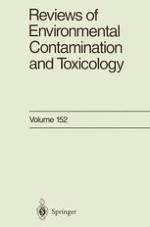1997 | OriginalPaper | Buchkapitel
Risk Assessment of Opportunistic Bacterial Pathogens in Drinking Water
verfasst von : Patricia A. Rusin, Joan B. Rose, Charles N. Haas, Charles P. Gerba
Erschienen in: Reviews of Environmental Contamination and Toxicology
Verlag: Springer New York
Enthalten in: Professional Book Archive
Aktivieren Sie unsere intelligente Suche, um passende Fachinhalte oder Patente zu finden.
Wählen Sie Textabschnitte aus um mit Künstlicher Intelligenz passenden Patente zu finden. powered by
Markieren Sie Textabschnitte, um KI-gestützt weitere passende Inhalte zu finden. powered by
Concern has been generated in the drinking water industry regarding the health effects of heterotrophic plate count (HPC) bacteria that are found in tap water, bottled water, and other sources of potable water. Heterotrophic bacteria are those that require organic carbon rather than carbon dioxide as a carbon source. All human bacterial pathogens are heterotrophic. The U.S. Environmental Protection Agency (EPA) has suggested that the heterotrophic bacterial counts in drinking water should not exceed 500 colony-forming units (CFU) mL-1, primarily because of the interference of coliform detection (USEPA 1989). Higher numbers are often the result of bacterial regrowth, particularly in distribution systems (Geldreich 1986; Olson 1982) and in water treatment devices (Geldreich et al. 1985; Payment 1989; Reasoner et al. 1987; Snyder et al. 1995). Some authors have expressed concern regarding the public health risk of some of these HPC bacteria (LeChevallier et al. 1985; Lye and Dufour 1991; McFeters et al. 1986; Payment et al. 1988).
